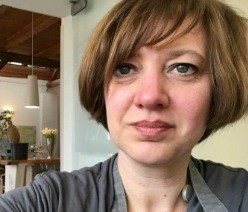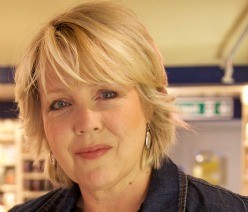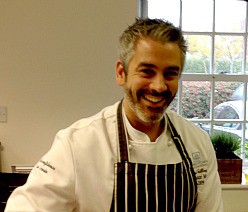Jo Fairley, founder of Green & Blacks, interviewed by Cat Black
April 24, 2012
Over hot chocolate, of course, Jo Fairley and I caught up and talked about life, the universe and launching a world conquering chocolate brand.
Categories:
-
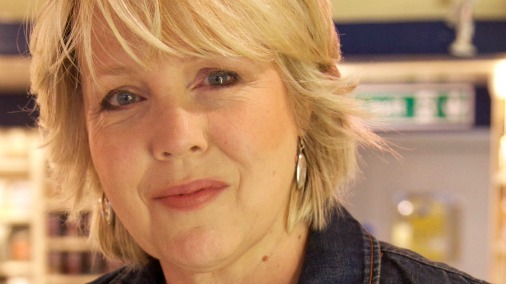
Cat Black: What was your background before Green & Black’s?
Jo Fairley: I have been a journalist for 36 years. I left school when I was 16 with six O levels and did a secretarial diploma. At 19 I ended up on a magazine. Having loved magazines all my life I knew it was what I really wanted to do. I worked my way up from being a secretary to being a senior feature writer. Then I became, at 23 the youngest magazine editor in the country. By the time I was 30, having edited various titles including Look Now and Honey, I had had enough of working for other people, so I went freelance. The great thing about having had all that experience as an editor is that I knew what people wanted from a writer. I was very successful at it and wrote about everything from Romanian orphans to Sumo wrestling. I also had a green column for the Times from 1988 to about 1991, when green issues were trickling through.
CB: Green was starting to enter our consciousness.
JF: Yes, it was the world’s first recyclable bin bag and Sting and Trudie’s rainforest Ball. There was a lot happening. A lot that we take for granted now began then. So I wrote about things in that movement. I knew Craig already (Craig Sams, Jo’s husband). He was founder of Whole Earth foods, he opened Europe’s first macrobiotic restaurant in 1967. When we got together romantically, at the end of the 80s, he was a real the pioneer of natural foods. I continued and continue to be a journalist, partly because I love not knowing what I am going to do next. But also because it has always enabled me to be that little bit ahead of everyone else in terms of what was going on, I am tapped in.
CB: I read magazines voraciously and always have done.
JF: I do sometimes wonder how anybody finds anything out if they don’t read magazines. Just about everything I know, I got from a magazine. Learning to cook, geography, travel, literature, music, all of those things. I read them from the age of 11. I started buying Vogue when I was 12, that was what I spent my pocket money on. So that is my work background, I had no business background at all. Other than that running a magazine is a bit like running a business.
CB: How did you go from there to start Green & Black’s?
JF: It came about because at that point Whole Earth had the number 2 peanut butter in the UK. I sometimes joke that I married him for his peanut butter, but it’s actually not that far from the truth. Craig was sourcing peanuts from all over the world. He ran a particularly sensitive test for a toxin that occurs in peanuts if they are not stored properly. It is called aflatoxin, and it is extremely carcinogenic. He was trying to buy these peanuts from a French Agronimist called Andre who was working with a group of Togolese farmers in West Africa, who had been sponsored to teach them to grow other things amongst their cocoa. They were under pressure from chemical companies and fertilizer companies to start using chemicals in this very virgin forest, and were being promised it would improve their yield. Andre was sent to teach them how they might be able to increase their income in another way, through other crops.
CB: Then they could resist the chemical companies.
JF: So they grew peanuts, and he offered them to Craig. But when the peanuts were tested they failed, they had too much aflotoxin. But they also had their cocoa beans, and asked, are you interested?
CB: The rest is history!
JF: But Craig said, my range has no sugar in, I can’t do chocolate. However, the world in natural foods was tiny, we had friends who he thought might be interested. But they wouldn’t have been in the business of just buying cocoa beans. We needed to create a product that we could show. Andre said that where he lived in France there was a small factory that did short runs for small clients. He could get the beans made into a bar. What kind of bar did Craig want? Some years before Craig had written to LIndt, having bought their 70% chocolate bar at Madrid airport, saying “Why don’t you sell this in the UK, this is my favourite kind of chocolate, the highest percentage you can get in the UK is 55, this seems mad. It is highly successful on the continent.” They never wrote back.
CB: Oh really? They left a door wide open.
JF: Just as well really. So Craig had it made into 70% chocolate. I didn’t know anything about it. I found two squares of it on his desk, when I came home from work one night. I ate it! And thought, wow what’s this? It is the best chocolate I have ever eaten!
CB: That’s such a lovely story.
JF: Craig said it was the world’s first organic chocolate, but that he wasn’t going to do anything with it, because obviously Whole Earth has a policy of no added sugar. He told me who he was thinking of giving it to. And I just went, no! I kept on at him. I was like a dog with a bone. Eventually he said; “If you’re so interested you do it!”
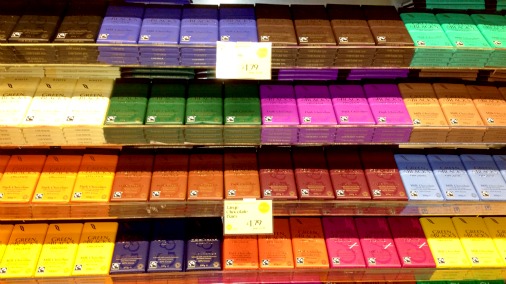
Green & Blacks Chocolate Bars
There was a precedent for this. My two stepchildren had set up a soft drink business. And there was infrastructure, there was a sales department, there was distribution. It was quite easy to bolt onto the side. Craig didn’t want to start a whole new brand from scratch himself because he had quite enough on his plate already. And there wasn’t money in the budget. But because I had sold my house before we got married I had some money in the bank. I took a punt. I bought a postcard when I was 16 of a man on a diving board that said; ‘If you don’t do it you’ll never know what would happen if you had done it.’ Several times in my life I had thought back to that.
CB: It became your mantra? Feel the fear and do it anyway.
JF: At times when the risk of not doing it felt greater than the risk of doing it. I thought; will I, at the end of my life, be sitting there thinking about what might have happened? So I did it. And it was bloody scary, buying 2 tonnes of chocolate, for £20,000, at the beginning of a heat wave in 1991. It literally had to sit in cold storage for six weeks, because the weather was so hot. This hadn’t occurred to me, that if you launch chocolate in the summer, it could just trickle down the M25 from a lorry. So it sat there until the autumn of 1991.
CB: I once spent a week in the factory Barry Callebaut factory in Banbury, and the greatest thing I learnt was about the physical conditions needed to work with chocolate and its fragility.
JF: That is why most chocolate is still made in the Alps, because it is cooler. Our factory in Italy still closes for a month in August, because it just gets too hot. You can’t make chocolate when it is that hot. Naively people often say, isn’t it unfair, shouldn’t we be encouraging cocoa farmers to make chocolate where they are, to add value there, to get the benefit of that extra income. But the logistics of trying to make chocolate in a hot country, you just can’t do it. You would have to have a refrigerated factory, you would have to have refrigerated transport from the moment it left the factory until it reached Paris or wherever.
CB: That is wildly expensive and environmentally appalling.
JF: It doesn’t make sense.
CB: I was going to ask what were some of the greatest discoveries you have made since starting Green & Black’s. I imagine that is one of them.
JF: The practicality of it. Also I have learnt a lot about chocolate. I knew I liked chocolate, and I knew what I liked. But I didn’t know very much about it at that point. I knew we would get distribution in the natural food market. Because Craig had a reputation as an innovator, and pretty much anything he did was accepted, and often copied. But it was actually very soon after that we also got into the supermarkets, into Sainsbury’s. I was sitting at my desk in my office in North Kensal Rise and the phone rang. (I had two phones on my desk. I would be on the phone to the editor of You magazine and I would go; “Hold on Dee”, and then, “Hello, Green & Black’s.” That is what it was like.) It was a Sainsbury’s buyer, saying that one of their directors had eaten some of our chocolate at a dinner party, and would we like to submit it to our next product review?
As it turned out, we found out later it was Lady Sainsbury, who had eaten it and encouraged her husband to stock it. We found that out because at one point, for whatever reason, Sainsbury’s were out of stock. We got this panicked call, could we bike it to Lady Sainsbury. She had run out, and I think she needed it for a dinner party. But that is when we found out the actual story.
CB: I remember you telling me, not long after we first met, that when you started positing the idea of putting 70% chocolate into supermarkets you were laughed at, nobody was interested.
JF: They did, they laughed in my face, they said the Brits would never buy it. It took one individual, it took Lady Sainsbury. It probably would have taken ages if she hadn’t asked her husband to stock it. Because there was this idea that you can’t go higher than 55%. The English love Dairy Milk and Aero, they are not sophisticated enough to enjoy this stuff.
CB: So, you can’t change a perception by offering things to people.
JF: That was the idea. I violently disagree. I think you shouldn’t underestimate people.
And a few very fortuitous things happened. A few months after we launched Green & Black’s the Chocolate Society was launched in the UK. There had been Chocolate Societies in other countries. What I didn’t realise is that Valrhona would put the seed funding in for a chocolate society when they launched in a particular market.
CB: How interesting. To support their launch?
JF: They were putting quite a lot of effort into educating people about the origins of beans, and different kinds of beans, and we were able to ride on the back of that. I have some issues with the whole origin obsession, because I think what matters is how well the chocolate is grown, made, fermented. Terroir can come into it. But I don’t good chocolate is necessarily the variety of the bean, I think there is a lot else around it. There is a bit of snobbery about Criollo against Forestero.
CB: I think that, like wine, there is great chocolate made of a variety of beans. And there is awful chocolate made of beans that have frankly been wasted on it. If you combine wonderful beans with wonderful making then you get something transcendent.
JF: But there is a lot of snobbery about aspects of chocolate production that are not particularly relevant. I learnt a lot from The Chocolate Society. Also we were fortunate, because every time they did a taste test, for a magazine, or whatever, it was always Valrhona. But they also always threw Green & Black’s in there because they didn’t want it to look partisan, and there wasn’t any other chocolate out there. And we always did incredibly well.
We also got a great boost from a popular book that came out, soon after we were launched, called Dine out and Lose Weight, by a doctor called Michel Montignac. He was the first person to talk about the glycaemic index. He actually prescribed 70% chocolate, and there just wasn’t any other available. We did well on the back of that.
And on the environmental side, the women’s environment network brought a book out called Chocolate Unwrapped. They had a researcher called Cat Cox, who spent about 2 years on the issues surrounding chocolate production. She discovered some real horror stories. Workers on plantations were getting all sorts of diseases and birth defects. She even came across one plantation where unless the women agreed to be sterilized they were not allowed to work. It was horrendous.
Happily a lot has changed since then. But the Women’s Environment Network had this really gloomy book to promote. And then along came Green & Black’s, so they were able to say there is one chocolate you can eat, that doesn’t do these dreadful things. And that was us.

The Academy of Chocolate presented this award to Jo and Craig Sams
CB: You were the light at the end of a tunnel.
JF: Yes, and they did a fantastic job of promoting us. There were all these things that happened really serendipitously to set us on our path. Then, once we had made 70% chocolate available in the UK, it was taken up by chefs and restaurants. It became the benchmark of what was used by the cooking fraternity. Whenever there was a recipe it was 70% dark chocolate, and in general when people went out to look for 70% dark chocolate, ours was what they found. Many chefs even specified Green & Black’s in the recipe.
CB: You have said quite a lot about the chocolate market when you began. What do you think has happened since then?
JF: We launched in 1991, then we launched the first Fairtrade product in 1994, which was Maya Gold. In between we had launched milk chocolate. What the supermarkets did say to us was that we couldn’t have a single product, that we needed a range. Although the chocolate was selling very well, people also wanted to have milk chocolate, they wanted to be able to give milk chocolate to their children. When we did do milk chocolate I think it had the highest percentage of any milk chocolate out there. We used to joke that it had more milk than dairy milk and more cocoa than Bourneville!
CB: Since then, what do you think has happened?
JF: We thought the stuff we were raised on was perfectly good, we certainly ate loads of it. I was at least part Dairy Milk, like most children. But I think once you have had the good stuff, it is quite hard to go back to the old. The only time I would ever resort to something really ordinary in the chocolate world is if I was on a train on my way back from somewhere, and it was a choice between a packet of crisps and a Kit Kat or a Twix. But out of choice I would never eat that now.
CB: There is so much more complexity of flavour in better chocolate.
JF: Yes, I think people have learnt to appreciate the flavours within chocolate. There are more flavour elements than any other food. There are 632, or something like that. All the different notes you have in it from burnt rubber, to lemons and cherries and red wine. You get this amazing complexity. And the thing about chocolate is, even if you get the very best bar, it’s not going to set you back more than a fiver. I personally don’t think you even need to spend that, because I love our chocolate, and it’s £2, or £2.25 now. But even if you went to Paul A Young, or L’Artisan du Chocolat, and buy the most wonderful thing they have it doesn’t cost that much. As pleasures go that it pretty good.
CB: I have been reading the debates on The Chocolate Festival website about the price of chocolate, about how people protest about how much things cost. And yet, especially for those people who are small makers, who don’t have economies of scale and want to make something excellent and buy the best beans, if it costs too little they can’t do it. It isn’t a fair price.
JF: No it isn’t. The thing with us is that when we launched in 1991 our price was £1.89, which was expensive. But as we grew, we were able to take up more factory days without them needing to clean the equipment. To clean a line, you have to put tons and tons of chocolate through it. I guess the labour and the real cost of a chocolate production is the changeover. We were £1.89 until last year, when the chancellor put the VAT up, because the unit cost kept going down the more we made. So that is the perfect illustration. Unless people are prepared to pay a little bit more, that producer is never going to get the unit cost down. It is a catch 22.
CB: Yes, if we knew a price was unfair for some coffee, now people would be up in arms. They have accepted the ideals of fair trade there. But if they are asked to pay more for an artisan chocolate bar they protest.
JF: I think it goes deep. I think the French have a different attitude, they understand food, and are prepared to pay for food, they understand the quality of ingredients. But it seems cock-eyed to me that in this country, and in the States, if you buy an Armani jacket, everyone goes, oh wow, an Armani jacket, that’s fantastic! If you buy a BMW, rather than a cheaper car, your friends go, wow, you have a great car. But if you pay 5p more for a loaf of bread you are regarded as an idiot.
CB: So where do you think the chocolate market is going to go next. Or what plans does Green & Black’s have?
JF: We have really carved out the bar territory, we are really good at bars, that is where we put our focus. But I am no longer really involved with that. We were bought by Cadbury’s in 2005. Now my role is as more of an unofficial ambassador for the brand. I no longer have control over the products, but we do always provide feedback.
The ones we did before we took in any investment was Dark 70%, Milk, Maya Gold, Hazelnut and Currant, White, Mint Fondant, Cherry. Then fantastic people came on board and we were able to do some product development. The problem before that, when we were just running it ourselves, we were growing so fast, everything was tied up in stock, so we didn’t have the money to invest in new packaging design, new recipes, trying out flavours, promotion, advertising or any of that stuff.
CB: Have you always been a foodie?
JF: Yes, I have always been a foodie. I grew up in a foodie household. I still remember when avocados first came in. My Mum used to do a lot of entertaining. I inherited from her the entire Robert Carrier part work.
CB: Do you cook a lot and did you have anything to do with the Green & Black’s cookbooks?
JF: I do cook a lot. For the first cookbook I only wrote the forward. But for the second one I tapped into all the people that I knew that were fans of Green & Black’s, got them to contribute recipes. We have met so many people through Green & Black’s. There is a very sweet story about Mary McCartney, she says when she wants to impress people she doesn’t tell them her Dads a Beatle, she tells them she knows the people who founded Green & Black’s!
CB: What a lovely story.
JF: We became really good friends with them because of Linda. In fact she had a family brownie recipe that she couldn’t get to work in the UK, because the recipe specified bakers chocolate, which is 100%, an American product. So she asked Craig to try and get her family recipe for brownies to work with Green & Black’s. He did just that, and it is still the family recipe that they use and that we use.
CB: What are you going to be doing next?
JF: Well Green & Black’s, and my perfume journalism. But at last count I do about seven different things.
CB: A renaissance woman.
The last thing I want to ask you is, what is your desert island chocolate and why?
JF: Well obviously it would be Green & Black’s, and I would have terrible trouble deciding. It would probably be Maya Gold. Every time I go back to it I think it is genius. Craig created Maya Gold, from a spice mix he had made for a Whole Earth spiced apple juice. He tried putting it in some chocolate, and it was amazing. On my desert island Maya Gold would bring home to me the Green & Black’s story. How we also changed the way people shop through fair trade, by making a product that would be as good or better than anything else around. That gives you the opportunity to spread the word and educate people. I think the fair-trade market and the organic food market are beholden to create something that is as good as, if not better than, anything that is out there.
To contact me… cat@chocolatecouverture.com

 I am a food writer, with special interest in, and huge enthusiasm for, chocolate! This blog is where I get to tell you about all the wonderful tastes, events, and people I come across in the world of chocolate.
I am a food writer, with special interest in, and huge enthusiasm for, chocolate! This blog is where I get to tell you about all the wonderful tastes, events, and people I come across in the world of chocolate.